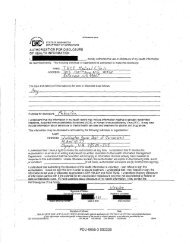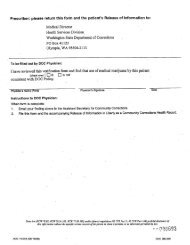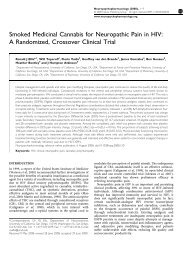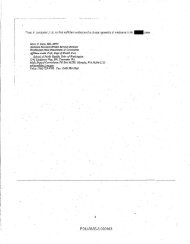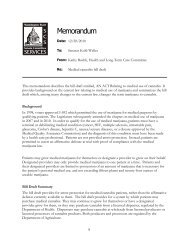Table 1 Patient characteristicsSex, n (%)* <strong>Cannabis</strong> (n 27) Placebo (n 28)Male 22 (81) 26 (93)Female 5 (19) 2 (7)Age, y, mean SD 50 6 47 7Race/ethnicity, n (%)White 14 (52) 11 (39)African American 9 (33) 12 (43)Lat<strong>in</strong>o 3 (11) 5 (18)Asian/Pacific Islander 1 (4) 0Duration of <strong>HIV</strong>, y, mean SD 15 4 14 5On HAART, n (%) 18 (67) 24 (86)CD4 T lymphocyte (cells/mm 3 ), median (IQR) 355 (250, 536) 444 (311, 523)Viral load, n (%)400 19 (70) 17 (61)400 8 (30) 11 (39)Duration of <strong>neuropathy</strong>, y, median (IQR) 7 (3, 9) 7 (3, 9)Cause of <strong>neuropathy</strong>, n (%)<strong>HIV</strong> 10 (37) 7 (25)Nucleosides 12 (44) 14 (50)Both 5 (19) 7 (25)Intensity of pa<strong>in</strong> at basel<strong>in</strong>e (0–100), mean SD 53 20 54 23Current cannabis use, n (%)Yes 21 (78) 19 (68)No 6 (22) 9 (32)Concomitant medications, n (%) 15 (56) 16 (57)Types of concomitant medications, n (%)†Gabapent<strong>in</strong> 7 (26) 7 (25)Opioid 5 (19) 8 (29)Other medication 9 (33) 10 (36)Multiple concomitant medications, n (%) 6 (22) 7 (25)* Male to female transgender for 1 cannabis and 2 placebo patients.† Multiple responses possible.ference among those who completed the study (26%; 95%CI 0, 51; p 0.05).Secondary outcome measures. Smok<strong>in</strong>g the first cannabiscigarette reduced chronic pa<strong>in</strong> rat<strong>in</strong>gs (AUC) by amedian of 72% vs a reduction of 15% with placebo cigarettes(p 0.001, Mann-Whitney test; figure 4A). On day 5just prior to smok<strong>in</strong>g the last cigarette, median rat<strong>in</strong>gs ofcurrent chronic pa<strong>in</strong> <strong>in</strong>tensity were lower <strong>in</strong> the cannabisgroup (15; IQR 7, 34) than <strong>in</strong> the placebo group (29; IQR 20, 60; p 0.006, Mann-Whitney test). Smok<strong>in</strong>g thelast cigarette further reduced chronic pa<strong>in</strong> rat<strong>in</strong>gs 51%<strong>in</strong> the cannabis group vs 5% <strong>in</strong> the placebo group(p 0.001, Mann-Whitney test).In the 30 patients who underwent the pa<strong>in</strong> model portionof the study, LTS (a measure of acute analgesia tonoxious heat stimuli) did not appear to be substantiallyreduced by smok<strong>in</strong>g the first cigarette on day 1 <strong>in</strong> eithergroup (figure 4B, median 22% for cannabis and 5%for placebo; p 0.31). Areas of experimental heat/capsaic<strong>in</strong>secondary hyperalgesia on the forearm were similar <strong>in</strong>518 NEUROLOGY 68 February 13, 2007the two groups prior to smok<strong>in</strong>g the first cigarette. Activecannabis reduced the area to both brush and von Frey hairstimuli compared to placebo (median 34% vs 11%;p 0.05 and 52% vs 3%; p 0.05; figure 4, C and D).Smok<strong>in</strong>g the last cigarette on day 5 did not alter the pa<strong>in</strong>fulnessof the LTS procedure or reduce the areas of secondaryhyperalgesia <strong>in</strong> either group.Safety and mood effects of cannabis. No patient withdrewfrom the study because of adverse events. One episodeof grade 3 dizz<strong>in</strong>ess related to study medicationoccurred <strong>in</strong> the cannabis group. One case of transientgrade 3 anxiety possibly related to study medication wasreported <strong>in</strong> each group. Both patients received a one-timedose of lorazepam. No other patients required psychotropicmedications for treatment of dysphoric effects. No episodesof hypertension, hypotension, or tachycardia requir<strong>in</strong>gmedical <strong>in</strong>tervention occurred.Mean recorded side effects were low <strong>in</strong> both studygroups. However, side effects rat<strong>in</strong>gs were higher <strong>in</strong> patients<strong>in</strong> the cannabis group, as shown <strong>in</strong> table 2, for anx-
Table 2 Mean side effect scores by study groupAdjusted estimates<strong>Cannabis</strong>, mean(95% CI)Placebo, mean(95% CI)Anxiety* 0.25 (0.14, 0.44) 0.10 (0.05, 0.22)Sedation† 0.54 (0.36, 0.81) 0.08 (0.04, 0.17)Disorientation† 0.16 (0.07, 0.34) 0.01 (0.00, 0.04)Paranoia 0.13 (0.03, 0.45) 0.04 (0.01, 0.14)Confusion† 0.17 (0.07, 0.39) 0.01 (0.00, 0.06)Dizz<strong>in</strong>ess† 0.15 (0.07, 0.31) 0.02 (0.01, 0.05)Nausea 0.11 (0.04, 0.30) 0.03 (0.01, 0.14)Figure 3. Time course of the <strong>in</strong>tensity of chronic neuropathicpa<strong>in</strong> as rated on the daily diary VAS at 8 AM forthe previous 24-hour period. Each po<strong>in</strong>t represents thegroup median. Study admission was at noon on study day–2, the first cigarette was smoked at 2 PM on study day 1,and the last cigarette was smoked at 2 PM on study day 5.iety (p 0.04), sedation (p 0.001), disorientation (p 0.001), confusion (p 0.001), and dizz<strong>in</strong>ess (p 0.001).Although these differences were significant, the values forboth groups hovered closer to zero than one and do notrepresent any serious safety concerns <strong>in</strong> this short-termstudy. The Profile of Mood States <strong>in</strong>dicated a reduction <strong>in</strong>total mood disturbance dur<strong>in</strong>g the 5 days of smok<strong>in</strong>g (median33% cannabis vs 29% placebo; p 0.28). Althoughall subscale scores decl<strong>in</strong>ed <strong>in</strong> both groups, the only differencewas a larger decrease <strong>in</strong> depression-dejection <strong>in</strong> theplacebo group (median 63% cannabis vs 76% placebo;p 0.05, Mann-Whitney test).Discussion. Over a 5-day <strong>in</strong>patient <strong>in</strong>terventionperiod, smok<strong>in</strong>g cannabis cigarettes three times aFigure 4. First smok<strong>in</strong>g session: time course dur<strong>in</strong>g thefirst 95 m<strong>in</strong>utes after smok<strong>in</strong>g of <strong>in</strong>tensity of chronic pa<strong>in</strong>as measured on the visual analog scale (A; cannabis n 25, placebo n 25), pa<strong>in</strong>fulness of LTS (B; cannabis n 14, placebo n 16), and areas of secondary hyperalgesiato brush and von Frey hair stimulation (C and D; cannabisn 14, placebo n 16). Mean 95% CI.Side effects were rated three times daily on a 0 to 3 scale (0 none, 1 mild, 2 moderate, 3 severe).* p, 0.05; † p 0.001.day reduced <strong>HIV</strong>-SN pa<strong>in</strong> by 34%, significantly morethan the 17% reduction with placebo cigarettes. A30% reduction <strong>in</strong> pa<strong>in</strong> has been validated as a cl<strong>in</strong>icallysignificant level of improvement. 23 In the currentstudy, half (52%) of those randomized tocannabis experienced at least a 30% reduction <strong>in</strong>pa<strong>in</strong>, while a quarter (24%) of those randomized toplacebo experienced a similar reduction <strong>in</strong> pa<strong>in</strong>.In this randomized, placebo-controlled study, thenumber needed to treat (NNT) on the primary outcomemeasure of 30% pa<strong>in</strong> reduction among allcomplet<strong>in</strong>g patients was 3.6 (1/[52%24%]). Trialsvary <strong>in</strong> their primary outcome measure, so compar<strong>in</strong>gNNT figures only approximates relative potency.The NNT for lamotrig<strong>in</strong>e was 5.4 for <strong>HIV</strong>-relatedpa<strong>in</strong>ful DSP. 4,24 Although one group of <strong>in</strong>vestigatorsreported success with gabapent<strong>in</strong>, their data analysisdoes not allow calculation of an NNT. 5 The NNT<strong>in</strong> the present study is comparable to that reported<strong>in</strong> trials of gabapent<strong>in</strong> for other types of chronic neuropathicpa<strong>in</strong>. In a large study of gabapent<strong>in</strong> forpostherpetic neuralgia the NNT was 3.4 and for diabetic<strong>neuropathy</strong> the NNT was 4.0. 25,26 A recentmeta-analysis of 107 controlled trials for neuropathicpa<strong>in</strong> showed that only tricyclic antidepressants andhigher potency opioids consistently achieved NNTvalues lower than 3.7. 24 However, for <strong>HIV</strong>-SN, tricyclicantidepressants were not effective. 9,10 Opioidshave not been systematically evaluated for pa<strong>in</strong>ful<strong>HIV</strong>-SN, but studies show efficacy across a broadspectrum of neuropathic pa<strong>in</strong> disorders. 27,28In addition to patient-reported changes <strong>in</strong> ongo<strong>in</strong>gchronic pa<strong>in</strong>, smoked cannabis attenuated the cutaneoushyperalgesia <strong>associated</strong> with central neuronalsensitization produced by a standardized experimentalpa<strong>in</strong> model. Although one cannot entirely excludepa<strong>in</strong> relief due to relaxation, a high, or unbl<strong>in</strong>d<strong>in</strong>g,the mood effects recorded argue aga<strong>in</strong>st such an explanation.Only one of the six Profile of Mood Statessubscales (depression-dejection) showed a significantgroup difference, and actually favored placebo. Moreover,rat<strong>in</strong>gs of side effects <strong>in</strong> the cannabis groupFebruary 13, 2007 NEUROLOGY 68 519




